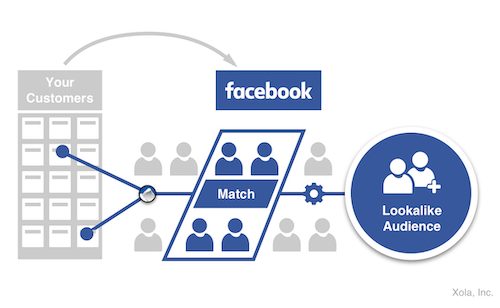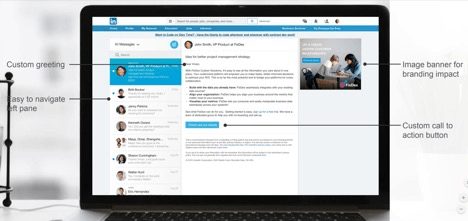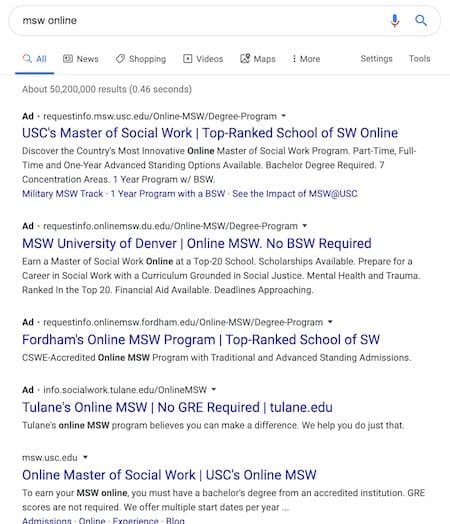Improve Your University’s Conversion Rate With These Higher Education PPC Tactics
In the increasingly competitive world of higher education marketing, you want to make sure you’re getting the most out of your ad budget. Usually the main KPI in higher education is application start/submit rate by which you can measure the quality of each lead based on the lead’s behavior.
As Facebook continues to be the preferred channel for influencing your prospects and introducing your program to potential students, Google remains the strongest channel for last touch conversion. Depending on the program, LinkedIn can be a great influence because its accurate targeting algorithm makes it an exceptional channel to target highly skilled and professional prospects.
But with new PPC strategies emerging all the time, it can be hard to know which tactic or channel is worth paying attention to. This is a question that we ask every year here at Archer Education. What is the best channel to generate more student leads and achieve your student enrollment goals?
Here’s what our team has to say about the most upcoming and relevant higher education PPC strategies and tactics of 2020 that every higher education marketer should be thinking about.
Create Lookalike Audiences
Farzin Espahani, Director of Paid Media & Analytics
 Lookalike audience targeting remains one of the most effective targeting strategies for 2020. As Facebook pixel is getting more and more intelligent in finding and matching new audiences based on your criteria, designing and implementing Lookalike campaigns should be a crucial part of your 2020 strategy.
Lookalike audience targeting remains one of the most effective targeting strategies for 2020. As Facebook pixel is getting more and more intelligent in finding and matching new audiences based on your criteria, designing and implementing Lookalike campaigns should be a crucial part of your 2020 strategy.
 Once you build a Lookalike audiences based on previous leads, applicants and enrolled students, Facebook will search, find, and match the most relevant audiences to your seed list.
Once you build a Lookalike audiences based on previous leads, applicants and enrolled students, Facebook will search, find, and match the most relevant audiences to your seed list.
I personally prefer to create and target three Lookalike audiences per seed list. If the geo targeted area is large enough (i.e National campaigns) a 1%, a 3% and a 5% lookalike audiences will be the most effective. As your Geo target shrinks (i.e. State level) you may need to give the Facebook pixel more room, so a 2%, a 4% and a 6% lookalike may be a better option.
Leverage Pixels and Tags
Andrew Glasser, Paid Media Team Lead
 Leveraging the pixel/tag is going to be bigger than ever in 2020. It seems that gradually our main platforms — Google/Bing, Facebook and even LinkedIn — are wrestling more control away from platform users & media buyers; placing it in the hands of their machine-learning algorithms.
Leveraging the pixel/tag is going to be bigger than ever in 2020. It seems that gradually our main platforms — Google/Bing, Facebook and even LinkedIn — are wrestling more control away from platform users & media buyers; placing it in the hands of their machine-learning algorithms.
Google is mostly concerned with ascertaining the intent of users’ searches; which plays well with the notion that voice search is becoming a more central part of how humans engage with search engines. I have a strong feeling that this year you will see more and more queries in your SQR which are tangential to the keywords you enter into the system.

Facebook is mostly concerned with gaining/retaining users on their platform and increasing time on site — doing so with quality engagement. Engagement should be a strong KPI in your cold audiences if it isn’t already.
That said, definitely experiment with your content this year to determine what is most engaging to which audiences; knowing that it will not likely be the same ad that will perform best across your prospective clientele.
I also highly recommend leveraging dynamic creative in your ad sets — it’s recently been revealed that running dynamic ads can saturate social proof on your sponsored post (e.g. instead of 4 ads, each with separate likes/share/comments, you get 1 dynamic ad with all of the social proof consolidated), which can also be carried into new campaigns.
Experiment with LinkedIn Mail
John Hetu, Paid Media Specialist
 As traditional channels become more competitive, 2020 will be a year of expanding to new platforms or utilizing features that might get overlooked. One in particular is LinkedIn InMail, as it is a great way to reach recently-graduated students as they begin job hunting on LinkedIn. One of the biggest advantages to InMail is the ability to reach students of all personalities.
As traditional channels become more competitive, 2020 will be a year of expanding to new platforms or utilizing features that might get overlooked. One in particular is LinkedIn InMail, as it is a great way to reach recently-graduated students as they begin job hunting on LinkedIn. One of the biggest advantages to InMail is the ability to reach students of all personalities.
 Each student processes information differently – some might want to start an application right away, while others prefer to read a brochure or attend a webinar. The possibilities are endless, but be concise and only stick to around 1-3 options.
Each student processes information differently – some might want to start an application right away, while others prefer to read a brochure or attend a webinar. The possibilities are endless, but be concise and only stick to around 1-3 options.
Try these tips to be successful with LinkedIn Mail:
- Use a person as a sender – no one wants to feel like another number, so make it personal and include a photo of who the student will be talking to.
- AVOID EXCESSIVE CAPS – don’t rely on caps to stand out, because LinkedIn will disapprove before you even start.
- Just because you can, doesn’t mean you should – InMail gives advertisers the ability to send up to 1,900 characters in the body. However, you will want to stay on track with your message, because chances are you’re not the only one in their inbox.
Understand a Student’s Journey
Martyna Lapinskaite, Paid Media Analyst
 Google Search Ads continues to be one of the strongest channels to convert leads to students, especially now that Google has changed the look of the search results page. Ads dominate above the fold space with quite an organic look, resulting in a higher chance to get clicked on before the user scrolls to the organic search results.
Google Search Ads continues to be one of the strongest channels to convert leads to students, especially now that Google has changed the look of the search results page. Ads dominate above the fold space with quite an organic look, resulting in a higher chance to get clicked on before the user scrolls to the organic search results.
Before jumping into keyword research and campaign structure, it’s important to understand a prospective student’s journey towards applying for a program. Previous student information can tell you about a student’s interests and influence the type of ad to create.

It’s no secret that PPC advertising in any industry is quite competitive, but PPC for higher education is one of the most expensive out there. Long-tail or broad+ brand keywords are a great start for building prospecting campaigns for users whose intent is higher than users who are just in the awareness stage and are searching for broader terms. This is where retargeting with display/video comes in handy.
We already know these people clicked on the ad and maybe they didn’t convert due to it being a bad time or them being unsure if it’s the right program for them. If it takes 3-6 months for a user to commit before a purchase, the awareness, consideration and decision stages of a user are important. Each stage plays a different role in educating a user why this particular program is the right fit and why he/she should take action.
Don’t Feel Like Running Ads Yourself? Let Our Team Help You!
Archer Education’s team of Paid Media experts is always up to date on strategies to help your program gain visibility and convert in prospective students’ search results. Our PPC tactics can help increase your conversion rate by:
- creating ad campaigns that increase visibility
- promoting engagement within the right circles
- custom tailoring a specific and informed paid media strategy that won’t blow your budget
Contact us or visit our Paid Media tactics page to learn more about how Archer can help you reach your enrollment goals.

